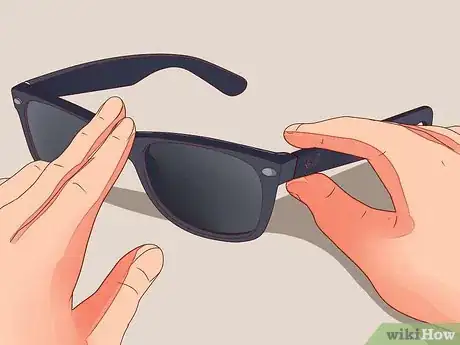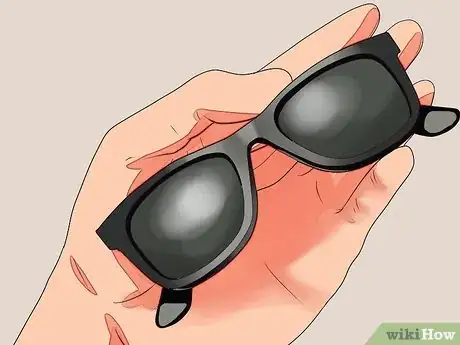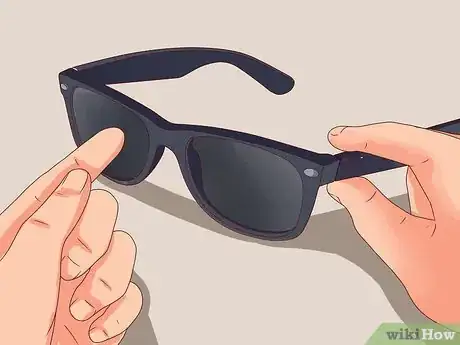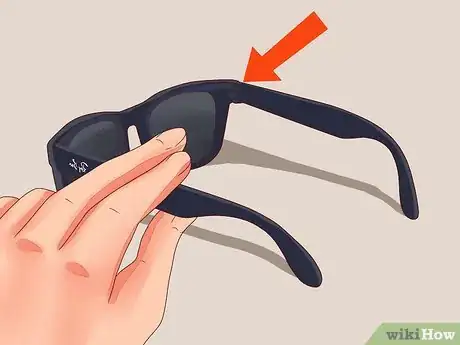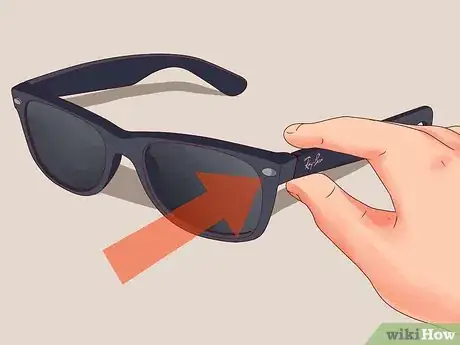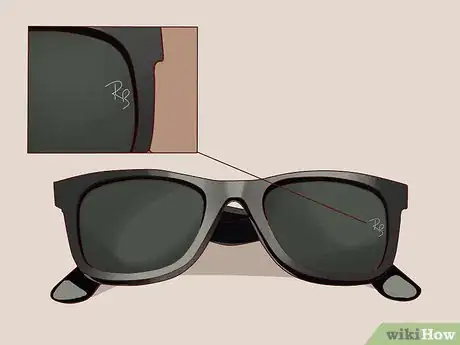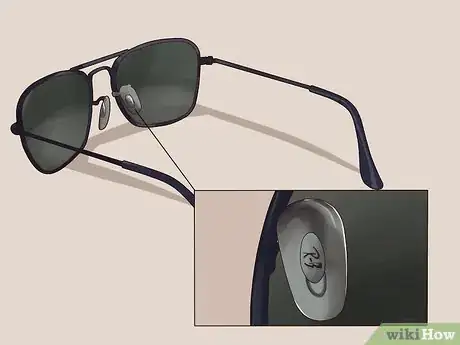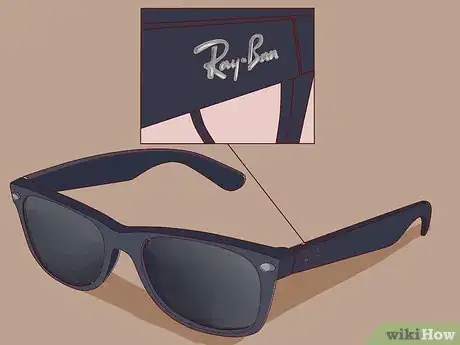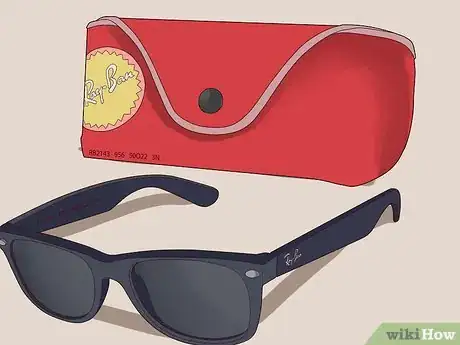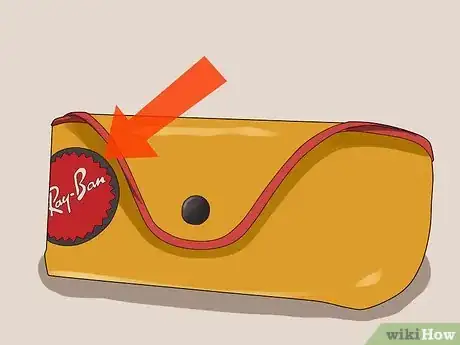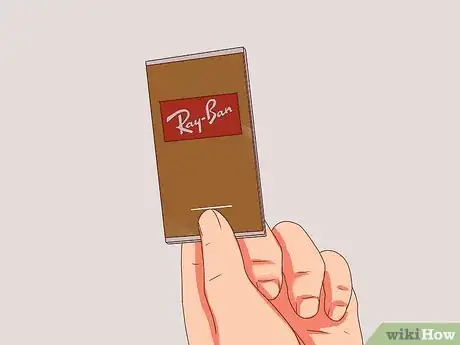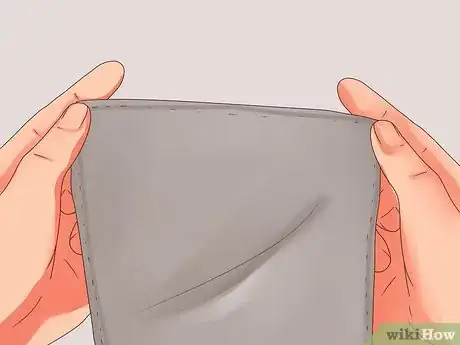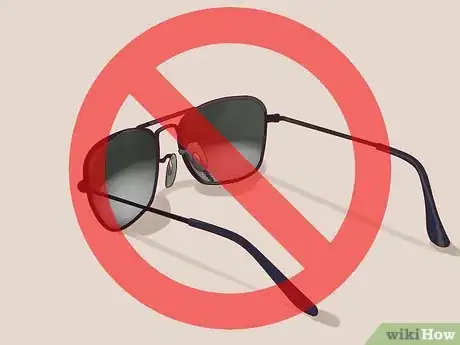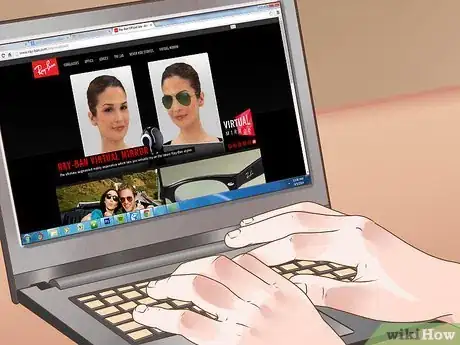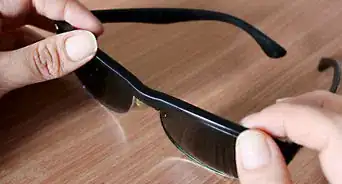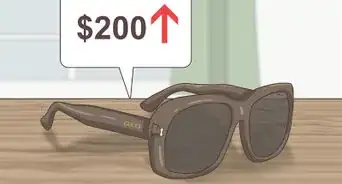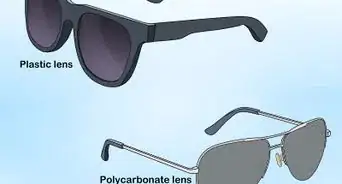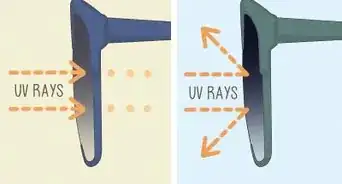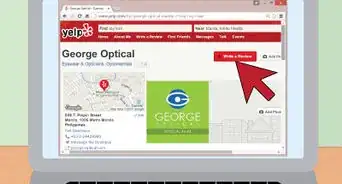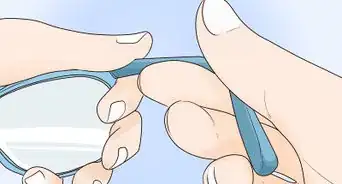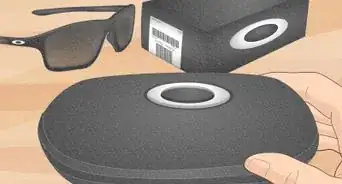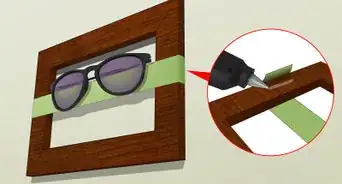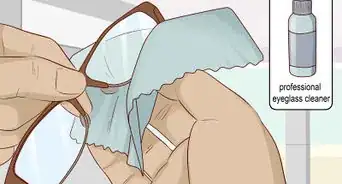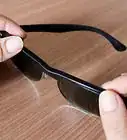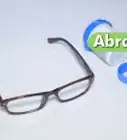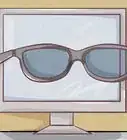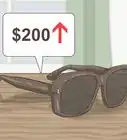wikiHow is a “wiki,” similar to Wikipedia, which means that many of our articles are co-written by multiple authors. To create this article, 41 people, some anonymous, worked to edit and improve it over time.
There are 7 references cited in this article, which can be found at the bottom of the page.
wikiHow marks an article as reader-approved once it receives enough positive feedback. This article received 19 testimonials and 97% of readers who voted found it helpful, earning it our reader-approved status.
This article has been viewed 2,266,960 times.
Learn more...
When it comes to a pair of shades, nothing beats the old-school cool of Ray-Bans. Whether you're aiming for the classic Wayfarer look, the Dirty Harry sheen of a pair of aviators, or the refined elegance of a pair of Clubmasters, there is no settling for anything but the best. Don't let yourself get robbed — be a smart consumer. Know how to tell the difference between the real deal and cheap imitations so you can wear your Ray-Bans with confidence.
Steps
Flaws
-
1Look and feel for seams on the plastic. All genuine Ray-Ban products are crafted from high-quality materials using the finest manufacturing processes. Notably, the plastic body of Ray-Ban sunglasses are cut from a single piece of acetate and are hand-polished. Because of this, you shouldn't be able to detect any nicks, rough spots, or especially seams on your glasses. These are after-products from cheap manufacturing processes and are dead giveaways that a pair of "Ray-Bans" aren't what they are being billed as.
- Seams can be anywhere on a fake pair of Ray-Bans, but they're especially likely to be on the places where the mold used to create the plastic closed — namely, the upper edges of the glasses above the lenses and the tops of the "arms" that rest on your ears.
-
2Feel for an inappropriately light weight. Take your Ray-Bans in your hands. Turn them over a few times. Gently toss them an inch or two up and catch them.They should have some weight to them and feel solid and substantial. They shouldn't feel unusually light, thin, or fragile. If your glasses seem like they may not be heavy enough to keep a few pieces of loose paper from blowing away, there's a good chance they're not real.
- Real Ray-Bans have metal support struts inside the “arms” that sit on your ears that are responsible for much of their weight. If you have a model with transparent arms (like, for instance, the Clubmaster Squares)[1] , you should be able to see this metal. If you can’t, you’ll know you’ve been wearing fakes.
Advertisement -
3Check for non-glass lenses. Take your glasses off and look at them from the front. Give the lenses a few gentle flicks with your fingernail. If they have the look, feel, and "clinking" sound of genuine glass, this is a good sign — many Ray-Bans use real glass for their lenses. Non-glass lenses don't necessarily mean that your glasses are fake, however, unless they're obviously cheap-looking, cloudy, or poor-quality.
- If your lenses don’t feel like glass, don’t panic — some models of Ray-Bans have non-glass lenses but are still made from the highest quality materials. To be clear, perfectly clear, glass lenses are a sign that your glasses are probably real, but non-glass lenses don’t necessarily mean they aren’t.
-
4Look for low-quality metal hinges. Open the glasses and look at them from the back. The hinges in the corners of the glasses should be of good-quality metal construction. They should be cleanly bolted to the glasses, not glued on or held in place with cheap plastic — as noted above, these are signs of cheap, rushed manufacturing processes.
- Many — but not all — Ray-Bans have a distinctive metal hinge that contains seven interlocking metal "teeth".> Seeing this is a good sign, but its absence shouldn't be cause for concern, as other types of high-quality metal hinges are sometimes used (for instance, for Ray-Ban's Aviators and Clubmasters).
-
5Look for low-quality engravings in the corners of the glasses. Look at your glasses from the front. If you're wearing most models of Wayfarers of Clubmasters, you should see small, silver, horizontal diamond or oval-shaped marks in the corners of the eyes. These should be sharp, shiny, and well-made. You shouldn't be able to scratch any of the shiny material off and they shouldn't seem like they can be easily removed. If the engravings don't look very well-made, there's a good chance that the glasses aren't, either.
-
6Look for a poor “RB” etching on one of the lenses. Most models of Ray-Ban glasses will have a small, almost-imperceptible "RB" etched in the trademark Ray-Ban font on one of the lenses. This will be small and near the edge of the lens, but it may be easier to see if you shine a light at the glasses from an angle. If your glasses are fakes, you may not be able to see this at all or it may appear smudged or sloppily-etched.
- Note, however, that some pre-2000 models may have a “BL” etching. This stands for “Bausch & Lomb,” the company that originally owned Ray-Ban. In 1999, Bausch & Lomb sold Ray-Ban to the Italian company Luxottica.[2] This new ownership is reflected on the labelling and packaging of modern Ray-Bans (see below).
-
7Check the quality of the nose pads. Every part of a genuine pair of Ray-Ban sunglasses is made from high-quality materials — even the little pads that sit on your nose when you wear the glasses. These should be made of a firm, comfortable rubbery material. They shouldn't feel fragile, slick, slimy, or easy-to-remove.
- You may also want to look for small "RB" logos embossed on the metal centers of the nose pads. These are included on many (but not all) Ray-Bans as a sign of quality.
-
8Check for flushness of the temple logo. Take off your glasses and look at them from the side. There should be a cursive "Ray-Ban" logo on the temple portion of the glasses. Look at this closely — it should be cleanly, professionally attached, sitting more or less flush against the "arm" of the glasses. If the logo itself seems poorly-made or stuck onto the side of the glasses with glue or pins, your glasses are probably not genuine.
- Obviously, for Ray-Ban models with very thin temple "arms", like Aviators, no logo is present.
-
9Look for the model number inside the “arms” of the glasses. Look at the inside of the "arms" of the glasses that rest on your ears. If you have Wayfarers or Clubmasters, you should see white text inside the arms. On the left arm, you'll see your glasses' serial and manufacturing numbers. On the right arm, you should see the Ray-Ban logo, "Made in Italy", and a stylized "CE" (which signifies that the glasses are certified to be sold in Europe). If this text is missing, smudged, or poorly-printed, your glasses are almost certainly fakes.
- If you still have your Ray-Bans' original packaging, check to make sure the serial numbers on the glasses match the ones on the box's label. If they don't, this is a sure sign of foul play.
- Again, because the "arms" of Aviators are so thin, no text is present inside the arms of these models.
Packaging
-
1Check the box’s label for the glasses’ serial numbers. If you bought your glasses new, they should have come in a box with a large white shipping label. This label should contain important identifying information for your glasses — if it doesn't, they're probably fake. Official Ray-Ban boxes should be labeled with the following:
- Model number: Starts with "RB" or "0RB", followed by four numbers.
- Submodel number: Starts with a letter, followed by four numbers.
- Lens type code: One letter/one number combination (e.g. "2N").
- Lens width (in millimeters): Two-digit number.
-
2Inspect the carrying case for high-quality construction. All Ray-Ban glasses should come with their own carrying case — if yours didn't (for instance, if your glasses came in a plastic bag), this is cause for concern, unless you bought them after-market (for instance, from a pawnbroker). The glasses' carrying case should have the following marks of good craftsmanship:[3]
- A sharp, shiny gold logo on the front left side. The logo should read "100% UV Protection - Ray-Ban - Sunglasses By Luxottica".
- A Ray-Ban logo on the snap.
- Material that is textured (and feels like) real leather.
- A hard, protective front portion.
- Clean stitching.
-
3Check the booklet for errors. Real Ray-Bans are usually packaged with a small booklet that discusses the product you've purchased, contains promotional images, and more. This booklet should be flawlessly printed from good-quality matte paper. In addition, real Ray-Ban booklets are thoroughly reviewed and edited before their publication. If the booklet contains any sort of error — whether it's a spelling, grammar, or factual error — this is a sign of trouble.
-
4Look for a high-quality cleaning cloth. Ray-Bans almost always come with a small felt cloth to be used for keeping the glasses clean. If this isn't included with the glasses in its own clear plastic envelope, your glasses may not be genuine. If the glasses do come with a cleaning cloth, but it appears poorly-made, this can also be a sign of a fake. Look for the following sorts of defects in the cloth:
- Stains or signs of previous use
- Thin, coarse, or ratty texture
- Loose stitching
- Cheap-looking material
-
5Look for a good-quality lens sticker. Ray bans are sold with a distinctive cling-on sticker on the lens as a sign of quality. This sticker should be black and gold (not yellow) and have the Ray-Ban logo prominently featured in the middle of a black starburst shape. The text around the edge should read: "100% UV Protection" and "Sunglasses by Luxottica." The following defects can be cause for concern:
- Missing or poorly-spelled text
- Off-center logo or starburst shape
- Glue under the sticker (it should attach via static, not like a conventional sticker)
Seller
-
1Buy only from licensed retailers. When it comes to buying Ray-Bans, not all sellers are created equal. Some, unfortunately, make a practice of selling fakes, or, in the case of pawnbrokers, may be indifferent to fakes in their inventory. To ensure that you only buy fine, high-quality Ray-Bans, only make purchases from sellers that are officially-licensed by the Ray-Ban corporation.
- If you live in the U.S., note that you can use the store locator on the official Ray-Ban site to find licensed sellers near you.[4]
-
2Beware “too good to be true” deals. As with many luxury goods, if your Ray-Bans seem to be a steal, they probably are. While Ray-Bans vary greatly in price depending on their make and model, they're never cheap. Being hand-made from the finest materials available, Ray-Bans are a premium good sold at a premium price. Be very skeptical of supposed Ray-Bans being sold under their market price, even if the vendor has some sort of convenient excuse for the discount.
- As an example of the sort of costs you can expect for new Ray-Bans, know that, within the Wayfarer group of models, new glasses can retail from about $60 to as high as $300.[5]
-
3When in doubt, purchase directly from Ray-Ban. If you're ever unsure of a seller's veracity, why take a risk? To make sure you get real Ray-Bans, simply buy from Ray-Ban's official website, ray-ban.com. The Ray-Ban site allows you to easily browse the entire Ray-Ban catalog, making it obviously preferable to any sort of "shady" seller you might otherwise use.
-
4Understand why wearing fakes is a bad idea. Like most knock-offs, fake Ray-Bans aren't nearly as high of quality as the real thing. They're almost always more poorly made, more likely to break, and not as good-looking. However, besides these obvious points, there are several other compelling things that may make fakes even less appealing to you as a buyer. Below are just a few additional reasons why you may want to avoid buying and wearing fake Ray-Bans:
- Fakes may not provide adequate protection from the sun’s UV rays. In fact, wearing sunglasses without UV protection can actually be worse for your eyes than wearing no sunglasses at all.[6]
- Fakes almost never come with warranties, so if they break (which is almost always more likely than with real Ray-Bans), you're completely out of luck.
- Fakes may be made in factories or sweatshops that exploit their workers. Making a habit of buying fakes can be unwittingly supporting unfair labor practices in other parts of the world.
Things You'll Need
- Good light for inspection
- Glasses if you wear them, for closer inspection
- Model numbers list from Ray-Ban website
References
- ↑ https://www.ray-ban.com/usa/sunglasses/clubmaster/plp
- ↑ http://www.nytimes.com/1999/04/29/business/company-news-bausch-lomb-selling-sunglass-business-to-luxottica.html
- ↑ http://snapguide.com/guides/identify-fake-ray-ban-wayfarers/
- ↑ https://www.ray-ban.com/usa/c/store-locator
- ↑ https://www.ray-ban.com/usa/sunglasses/wayfarer/plp
- ↑ http://healthland.time.com/2009/08/04/can-cheap-sunglasses-be-bad-for-your-eyes/
- ↑ http://iloveraybans.blogspot.com/2010/09/how-to-spot-fake-ray-bans.html
About This Article
To tell if Ray-Ban sunglasses are fake, start by feeling for seams on the plastic. Since Ray-Ban sunglasses are cut from a single piece of acetate and hand-polished, you shouldn't be able to feel any seams. Next, make sure the lenses are made of real glass. Then, look for low-quality metal hinges and poor engravings, which are red flags that the glasses are fake. Check the box for the serial numbers and inspect the booklet for errors. Always buy your Ray-Bans from licensed retailers and be wary of any deals that seem too good to be true! If you want to learn how to check the packaging on your Ray Ban glasses, keep reading the article!
